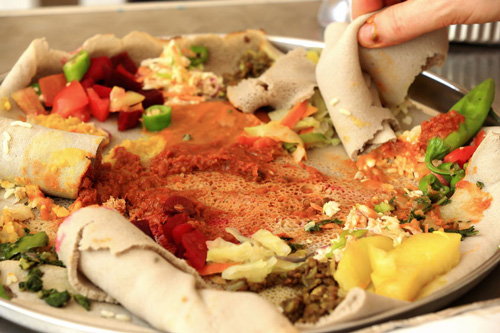After Reading What Despecisto Means in English
Reading Comprehension Text and Exercises
Interesting Dining Manners in Dissimilar Cultures
Effectually the globe, people gather to eat lunch or dinner. Every culture has developed this social ritual in different means, and so today in that location are certain rules that need to exist respected while eating – for example, how to use utensils (knife, fork, spoon) correctly or when to enquire to be served. We call them dining or table manners.
These rules differ from one culture to another, so what is considered to exist polite in 1 club can exist seen as very rude somewhere else!
Click Here for Step-by-Step Rules, Stories and Exercises to Practice All English language Tenses

A Brief History of Table Manners in Europe
- Near table manners that Europeans and North Americans exercise today originate from the Historic period of Exploration in the 1500s. It is believed that dinners became more than refined when Catherine de' Medici, who was the Pope's niece, married the future King of France Henry II. She was appalled by the fact that French people did non use forks, and had greasy hands from cut the meat.
- Around that time, a few more than educated people, like Erasmus of Rotterdam (a Dutch scholar), had already written about the use of utensils and restraining oneself from eating speedily. At that time, knives, spoons and cups were shared amidst all those sitting at the table, and soups were drunk straight from the bowl.
- Presently after, individual cutlery was introduced, and napkins were adopted to protect the diners' dress. Even today, information technology is a adept table manner to put the napkin on the lap.
Hands Up, France
When in France, yous might be advised to always residuum your wrists or forearms (but not elbows) on the table while you are not using utensils to swallow. Keeping your easily under the tabular array where nobody can encounter them is considered a bad dining manner.
In many other countries in Europe and Due north America, "hands on the table" is one of the basic dining rules, especially reiterated to children. Why is that? Some people propose this tradition started because people were afraid of what other people might be doing under the table, like property a weapon.

Siesta, Spain
If yous find yourself in Espana during the summertime, you lot volition notice that many shops are closed in the early on afternoon, even on a regular work mean solar day. The reason they are closed is siesta, a short nap people take after lunch.
The word siesta, pregnant "nap" in Spanish, derives from the Latin word sexta, significant the sixth hour (counting from the dawn), which explains why siesta is unremarkably taken effectually noon.
This particular dining ritual can be explained by the very high temperatures during the summertime, and the swell corporeality of food a typical midday meal in Spain includes. These ii together make people very sleepy, so they made it a nation-broad acceptable habit to take a break from work in the middle of the day and go some rest.

Slurping, East and Southern asia
While in near European cultures making whatsoever noise while drinking or chewing is considered to be very rude, in places like Japan and China those who slurp their soups have good dining manners.
In other words, slurping your soup or noodles very loudly sends a bulletin to the chef or the host that the food is delicious. The more loudly you slurp it, the more than appreciation for the meal you lot show. If by any chance yous forget to do it, the cook could be very offended or hurt thinking that you did not enjoy their meal!

Eating With Hands, Ethiopia
Traditionally, Ethiopian food is eaten with hands, unremarkably from a large communal plate. Several delicious meals are put together in a plate with some injera, a flat Ethiopian bread, and the guests sit around information technology.
The proper way to eat Ethiopian nutrient is to tear off a piece of the bread, grab some nutrient that is close to you with information technology, and put it in your rima oris. Considering you are touching the food with your hands, brand certain that y'all always launder them before and later the meal. The left paw is considered unclean, so it is advisable and polite to simply employ your right hand to eat.

No Extra Cheese, Italian republic
Italian cuisine is known for using a great variety of cheese in large quantities. Italian pizzas and pastas are particularly rich in cheese. In an Italian restaurant anywhere in the world, the parmesan cheese might even be freshly grated in front of you on your plate.
However, unless cheese is offered to you, you should not ask for extra cheese for a dish like pizza which already has a lot of cheese. Such an act is considered to be an insult to the cook, so nigh waiters will simply pass up to bring more cheese.
Another cheese-related rule in Italy applies to seafood – calculation cheese to a seafood pasta is unimaginable co-ordinate to traditional dining manners, so information technology is best you avoid it.

Comprehension Exercises
Vocabulary Questions
- What does "reiterate" mean?
- demand
- echo
- forgive
- What does "appalled" mean?
- feeling shocked or disgusted
- being concerned
- liking something very much
- What does "refined" hateful?
- improved, elegant
- rejected, disliked
- done again
- What does "cutlery" mean?
- the human activity of cutting bread
- decrease one's debt
- cutting utensils
- What does "exploration" mean?
- hiding something from someone
- searching and finding out about something
- changing the rules
Collocation Questions
- Many shops in Espana are closed in the __________ afternoon.
- principal
- early
- outset role of the
- Italians eat cheese in large __________.
- quantities
- sums
- volumes
- You should always __________ your wrists on the tabular array.
- lay
- relax
- residuum
- Ethiopian nutrient is normally served in a big __________ plate.
- communal
- mass
- articulation
- Asking for more cheese is an insulting __________.
- gesture
- act
- move
- Showtime eating by tearing __________ a piece of breadstuff.
- up
- abroad
- off
- In many cultures, the left mitt is considered __________.
- impure
- unclean
- stained
- Catherine de' Medici was appalled __________ the beliefs of the French.
- virtually
- of
- past
- Taking a siesta is __________ addiction all over Spain.
- an acceptable
- a justifiable
- a endurable
- Erasmus thought people should __________ themselves from eating quickly.
- repress
- restrain
- limit
Wh Questions
- Why practice people take siestas?
- considering the weather is hot
- because the law requires information technology
- because cooking takes a long time
- Where should you lot put your napkin during dinner?
- around your neck
- on the tabular array
- on the lap
- What should you never add to seafood in Italy?
- pasta
- cheese
- olive oil
- How does slurping compliment the cook in Japan?
- it means they will get a tip
- it ways the nutrient is delicious
- it means they are good-looking
- When did Europeans adopt forks and spoons?
- from the 16th century onwards
- 2,000 years ago
- in the 20th century
Evaluating Statements
- Based on the information in this lesson, which argument is true?
- Siestas always last from 3pm to 5pm.
- Siestas are normally taken around midday.
- Based on the information in this lesson, which statement is false?
- When in France, the best advice is to balance your elbows on the table.
- When in France, the best communication is to rest your wrists on the table.
True or Simulated?
- Based on the information in this lesson, is the following statement true or imitation?
"During a meal in Ethiopia, always reach across the table to go food."
- True
- False
- Based on the data in this lesson, is the following statement truthful or fake?
"In Italy, if the waiter offers you lot cheese, it is okay to take it."
- True
- False
Answer Cardinal
one. C | 2. B | 3. A | 4. C | v. A | vi. C | 7. A | eight. A | 9. B | ten. C | 11. B | 12. A | 13. A | xiv. C | 15. B | 16. A | 17. B | 18. C | xix. A | 20. B |21. B | 22. A | 23. B | 24. A
Source: https://www.really-learn-english.com/english-reading-comprehension-dining-manners.html
Post a Comment for "After Reading What Despecisto Means in English"